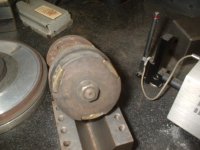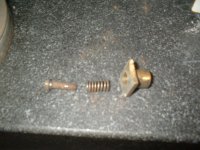The brake dresser actually puts on the brakes so the dresser wheel is turning slower than freewheeling.
Freewheeling would only crush dress and crush dressing is not suitable for super abrasive wheels. The slower dresser speed makes a grinding action to the wheel being dressed. Additionally, the brake action restricts the dresser RPM to be less than the blow-up speed which is about 8200 to about 12.000 depending on the dresser wheel brand..
We would take a pencil eraser end to give the dresser wheel a little spin so it would start on the wheel with no radial bearing vibration or start-up shock to the grinding wheel.
Angle brake dressers were mad that had a dresser wheel in a shaft to set on the Mag at 45*, the angle would restrict the RPM, and with being an angle would cause the needed grinding/dressing action.
I am not sure about using a brake dresser on an AO or another non supper abrasive wheel. It seems that most break dresser wheels were about 100 to 15O grit and very, very hard, the hardness might tend to dull an AO or green wheel's grit.
A green wheel will dress a diamond wheel(likely a CBN also?), but it takes a lot of green wheel so only good when machine time is a factor. A diamond wheel can be put on the likes of a motorized TC grinder workhead and dressed. Yes you may use $15.00+ worth of green wheel to take .005-.010 off a 6" diamond wheel. Suppose a CNC grinder is making $100 and hour+, and the apprentice can put a fresh sharp corner on 3 or 4 wheels in an hour (perhaps a 60* 6" x 1/4 x 1 1/4 with a max .o10 corner radius wheel)
Where shutting down the CNC and setting up the brake dresser on the CNC might take a half-hour to dress one wheel. To do this one likely has to have a TC grinder pre-set-up so it runs dead-true with no fiddling to make true. *YES, a break dresser mounted on a TC grinder would be better.
Penn tool and National Labs often have a good new price on new brake dressers.
The old Nortons were very good and often to be bought used on ebay or the like.



